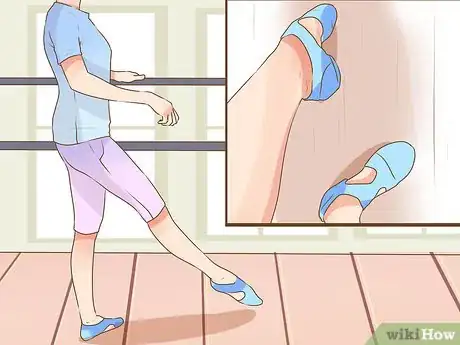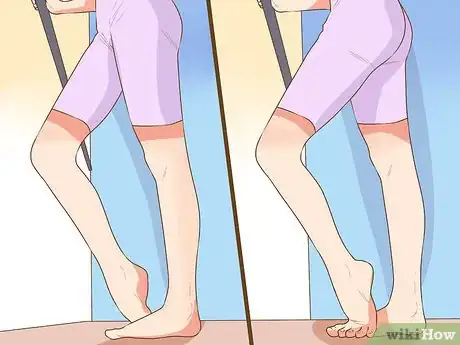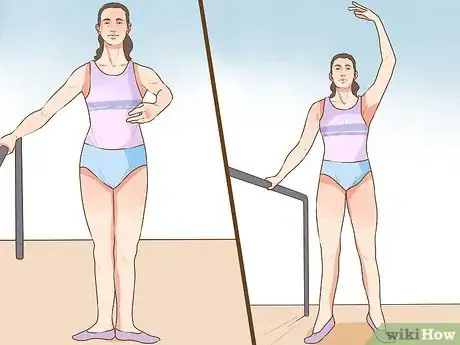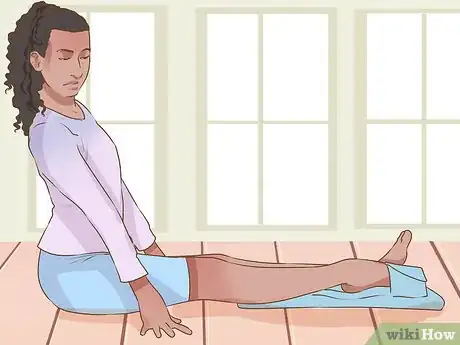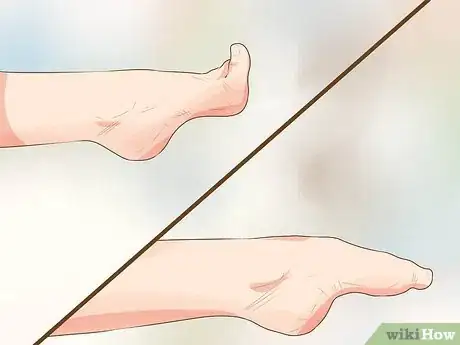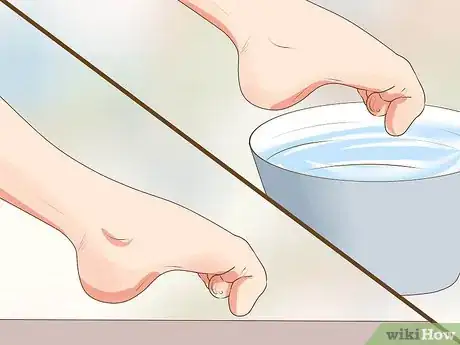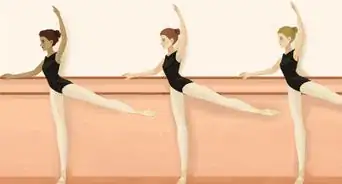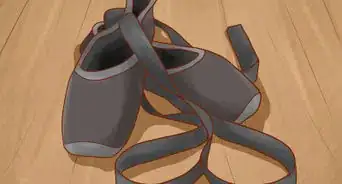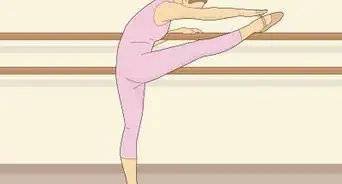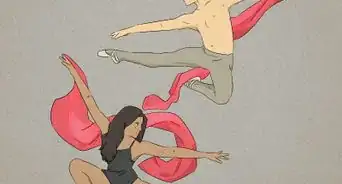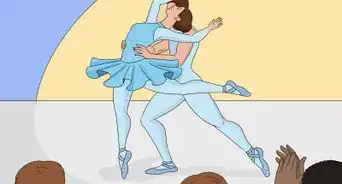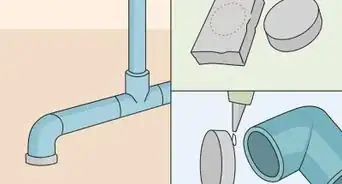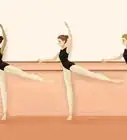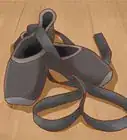This article was co-authored by Geraldine Grace Johns. Geraldine Grace Johns is a Professional Ballerina and the Owner of Grace Ballet in New York and Los Angeles. Geraldine toured through New Zealand, Australia, Japan, and Korea as Jammes in Ken Hill's Original Phantom of the Opera. She has studied with the Royal Academy of Dance in London to become a teacher and taught for the Kudo School of Ballet in Yokohama. Geraldine also ran her own Royal Academy of Dance School in New Zealand before studying at the Neighborhood Playhouse School of the Theatre in New York City. Geraldine was a guest coach and Master Class teacher in Toronto for the Canadian Royal Academy of Dance's Dance Challenge in 2018, 2019, and 2020. She was also a guest coach and Master Class teacher for the USA Royal Academy of Dance Challenge in Long Beach, California in 2019 and 2020. Grace Ballet Los Angeles has won recognition as one of 13 Best Ballet Schools in Los Angeles since opening her school. Geraldine is a contract Practical Teaching Supervisor for the Certificate in Ballet Teaching Studies for the Royal Academy of Dance.
There are 11 references cited in this article, which can be found at the bottom of the page.
wikiHow marks an article as reader-approved once it receives enough positive feedback. This article received 18 testimonials and 97% of readers who voted found it helpful, earning it our reader-approved status.
This article has been viewed 166,404 times.
As a dancer, your feet are some of your most valuable assets, so it’s very important to keep them strong, flexible and healthy. You may not be able to alter the bone structure of your foot or change where your arch is positioned, but there are many exercises you can do to strengthen and improve flexibility in your feet and arches.
Steps
Improving Strength and Endurance
-
1Practice your tendus. Stand at the barre in first position. Slowly, extend your foot to a full point in front of you, massaging the floor with your foot as you go. Then, starting the movement with your toes, retrace your tendu motion back into first position.[1]
- Repeat this motion ten times going forward, ten times going sideways and ten times going backwards.
- Use your heel to push you forward, let your toes lead on the way back.
- When your foot is extended to the front, make sure it is lined up in front of your bellybutton.
- The more repetitions you perform, the more your endurance will increase. As you build up strength and stamina, add more repetitions to your practice time to further increase your endurance.
-
2Strengthen your feet with a Therapy Band. Therapy Bands can be purchased online or in stores and are a must have for all dancers. Sit on the floor with your legs extended. Wrap the band around one of your feet and use your hands to grip the ends of the band. Hold the band tight to increase resistance and alternate between pointing and flexing your toes.[2]
- To make the exercise even more beneficial, try doing the exercise while focusing on one part of your foot at a time. Isolate your ankle and point only with your toes. Then isolate your toes and point through your ankle.
Advertisement -
3Write the alphabet with your toes. This is a great exercise for improving ankle strength. Sit in a chair with one leg outstretched. Leading with your toes, write the entire alphabet in the air. Then switch feet and perform the same exercise with your other foot.[3]
- Make sure to use capital letters, not lowercase.
- After you finish the alphabet, try writing your name or even entire sentences.
Strengthening Your Arch
-
1Do prance exercises. Stand facing the barre. Stand on your tiptoes and bend your right knee, forcing your weight onto your right toes and driving your left heel towards the floor. Then switch feet. Alternate between the two feet to complete two sets of eight.[4]
- It doesn’t really matter what you hold onto, as long as it’s something stable. If you don’t have access to a barre, try using a countertop or the back of a dining room chair.
- Try repeating the prance exercise again, but turned out into first position.
-
2Practice your releves. Stand at the barre in first position. Rise onto your toes, into what’s known as demi pointe and then slowly return your heels to the floor.[5]
- Your weight should be centrally positioned. Don’t put too much weight on your big toe or baby toe.
- Glue your inner thighs together and engage your abs.
- Practice your releves until you can easily do 8 on the right side and 8 on the left. This will strengthen your metatarsal, or the ball of your foot.[6]
- You can also do risers to strengthen your feet. Stand with your feet in parallel, then rise up, keeping your ankle bones together as you do so.[7]
-
3Try the Towel Scrunch. Sit on the floor with your feet extended in front of you. Place a hand towel at the tip of your toes. Grabbing the towel with your toes, pull it towards you until it is fully gathered under the arch of your foot.[8]
- To reduce cramping, roll your arch out with a golf ball. Place a golf ball under your foot and roll it from your toes to your heels. Spend fifteen seconds under your toes, under the arch of your foot and then under your heel. Then slowly roll the ball back and forth without stopping.
- Try freezing the golf ball for the ultimate roll out.
Improving Flexibility
-
1Use a foot stretcher. Sit on the floor and place one foot into the stretcher. Straighten your knee, slowly, until you feel a push on the top of your foot.[9] Do this exercise once a day for a couple of minutes and gradually add on over time.
- Take care not to overstretch your foot. You should never feel more than a small amount of pressure while stretching. If your foot gets overstretched, take a break from stretching for a few days.
- Foot stretchers are available online or you can make your own. Take a sanded piece of wood (about two times the length of your foot) and use a glue gun to glue a sock around the circumference of the wood. Take a Thera-Band (which you can buy online) and tie it in a knot a fist’s width away from your sock. Slip your toes through the knot in the Thera-Band and rest your heel on the sock to stretch out your foot.[10]
-
2Do toe sit-ups. Sit on the floor with your legs outstretched. Point your toe, then slowly lift just the toes up and then point your toes again. Do three sets of twelve every day to achieve maximum results with this exercise.[11]
- Make sure to isolate your toes from the rest of your feet, so the only part of your foot that is moving is your toes.[12]
- Focus on keeping your leg straight as well. Do not let it rock from side to side.
-
3Do a marble pick up. To do this exercise, you will need twenty marbles and a bowl. Place the marbles on the floor and then take a seat next to them. One by one, pick the marbles up with your toes and place them into the bowl.[13]
- This exercise is especially helpful if you’re having pain in the ball of your foot or cramps in your toes.
Expert Q&A
Did you know you can get expert answers for this article?
Unlock expert answers by supporting wikiHow
-
QuestionHow do I strengthen my feet for ballet?
 Geraldine Grace JohnsGeraldine Grace Johns is a Professional Ballerina and the Owner of Grace Ballet in New York and Los Angeles. Geraldine toured through New Zealand, Australia, Japan, and Korea as Jammes in Ken Hill's Original Phantom of the Opera. She has studied with the Royal Academy of Dance in London to become a teacher and taught for the Kudo School of Ballet in Yokohama. Geraldine also ran her own Royal Academy of Dance School in New Zealand before studying at the Neighborhood Playhouse School of the Theatre in New York City. Geraldine was a guest coach and Master Class teacher in Toronto for the Canadian Royal Academy of Dance's Dance Challenge in 2018, 2019, and 2020. She was also a guest coach and Master Class teacher for the USA Royal Academy of Dance Challenge in Long Beach, California in 2019 and 2020. Grace Ballet Los Angeles has won recognition as one of 13 Best Ballet Schools in Los Angeles since opening her school. Geraldine is a contract Practical Teaching Supervisor for the Certificate in Ballet Teaching Studies for the Royal Academy of Dance.
Geraldine Grace JohnsGeraldine Grace Johns is a Professional Ballerina and the Owner of Grace Ballet in New York and Los Angeles. Geraldine toured through New Zealand, Australia, Japan, and Korea as Jammes in Ken Hill's Original Phantom of the Opera. She has studied with the Royal Academy of Dance in London to become a teacher and taught for the Kudo School of Ballet in Yokohama. Geraldine also ran her own Royal Academy of Dance School in New Zealand before studying at the Neighborhood Playhouse School of the Theatre in New York City. Geraldine was a guest coach and Master Class teacher in Toronto for the Canadian Royal Academy of Dance's Dance Challenge in 2018, 2019, and 2020. She was also a guest coach and Master Class teacher for the USA Royal Academy of Dance Challenge in Long Beach, California in 2019 and 2020. Grace Ballet Los Angeles has won recognition as one of 13 Best Ballet Schools in Los Angeles since opening her school. Geraldine is a contract Practical Teaching Supervisor for the Certificate in Ballet Teaching Studies for the Royal Academy of Dance.
Professional Ballerina & Ballet Instructor Footwork is very important—it takes a lot of repetitive exercises, and it's very hard. One thing you can do are rises. Have your feet in parallel, then rise up, keeping your ankle bone together as you do the rise. You can also do releves—stand in first position, then releve onto your Demi pointes, 8 on the right and 8 on the left.
Footwork is very important—it takes a lot of repetitive exercises, and it's very hard. One thing you can do are rises. Have your feet in parallel, then rise up, keeping your ankle bone together as you do the rise. You can also do releves—stand in first position, then releve onto your Demi pointes, 8 on the right and 8 on the left. -
QuestionWhat is the best angle for my feet in first position in ballet?
 Community AnswerMost dancers aim to have a perfect 180 degree angle in first, but you should never force your turnout to the point of pain. It generally takes years to get your first all the way turned out. Until then, be safe and stretch every day.
Community AnswerMost dancers aim to have a perfect 180 degree angle in first, but you should never force your turnout to the point of pain. It generally takes years to get your first all the way turned out. Until then, be safe and stretch every day. -
QuestionAm I supposed to do all of these exercises every single day?
 Community AnswerYou don't have to do them every day. I do these every other day, so Monday, Wednesday, Friday, and sometimes on the weekends. It is always good to give your feet a rest so you don't snap or pull a tendon!
Community AnswerYou don't have to do them every day. I do these every other day, so Monday, Wednesday, Friday, and sometimes on the weekends. It is always good to give your feet a rest so you don't snap or pull a tendon!
Warnings
- Go slowly. Putting too much pressure on your body can result in injury. If anything feels off or hurts, stop doing it immediately and talk to a teacher or parent. If necessary, consult a doctor.⧼thumbs_response⧽
References
- ↑ https://www.youtube.com/watch?v=zeSVHYSMItg
- ↑ https://ballethub.com/ballet-lesson/improving-feet-ballet/
- ↑ https://www.youtube.com/watch?v=7THSuY-YSNg
- ↑ https://www.youtube.com/watch?v=3f8vPl27b_s
- ↑ Geraldine Grace Johns. Professional Ballerina & Ballet Instructor. Expert Interview. 11 November 2020.
- ↑ Geraldine Grace Johns. Professional Ballerina & Ballet Instructor. Expert Interview. 11 November 2020.
- ↑ Geraldine Grace Johns. Professional Ballerina & Ballet Instructor. Expert Interview. 11 November 2020.
- ↑ http://balletforadults.com/3-types-of-ballet-feet-and-how-to-use-them/
- ↑ https://ballethub.com/ballet-lesson/improving-feet-ballet/
